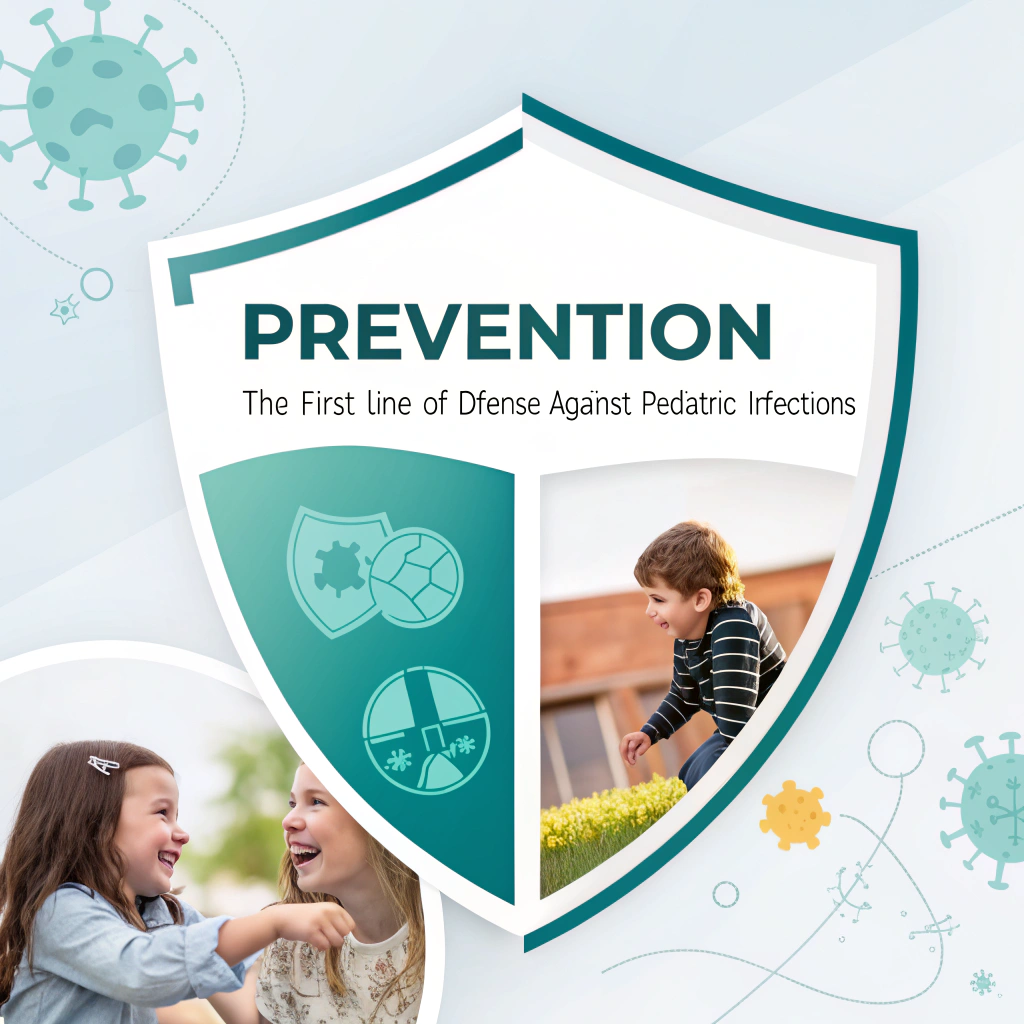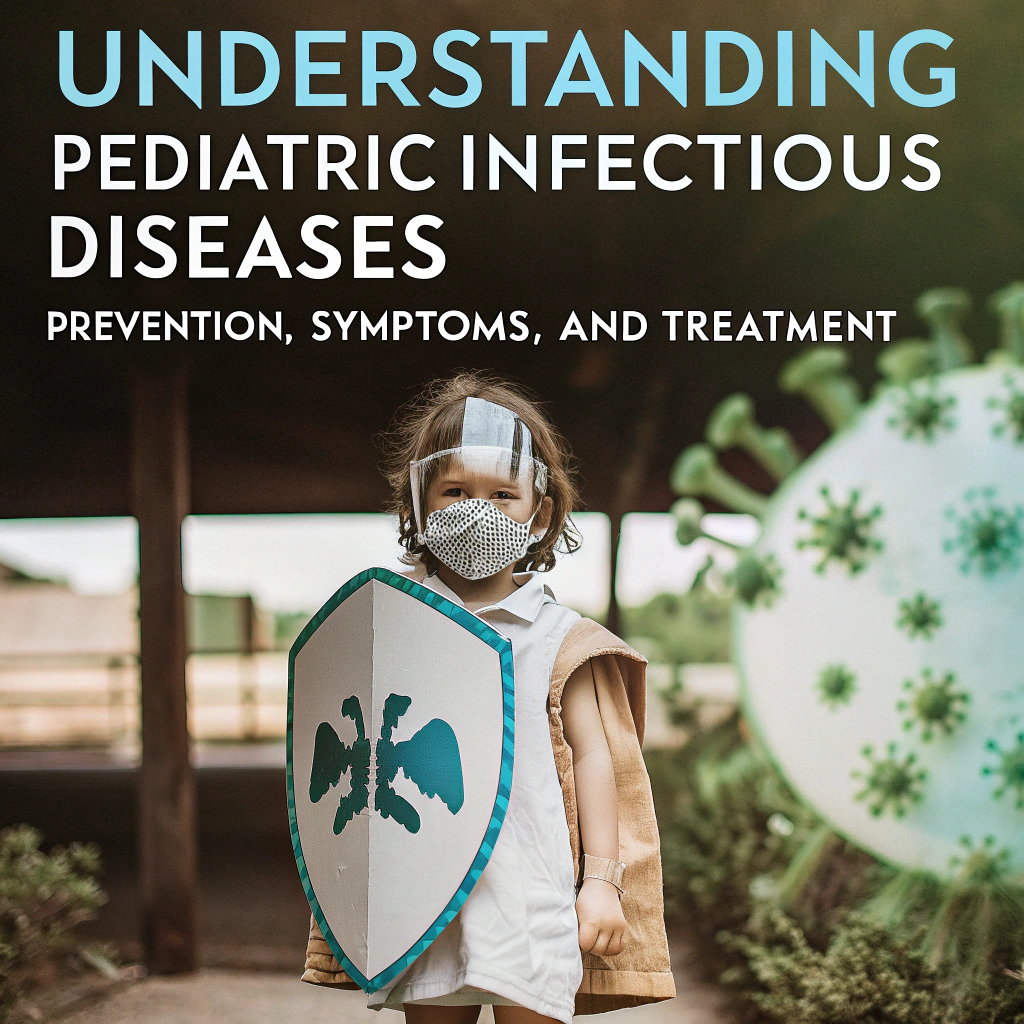Pediatric infectious diseases are a significant concern for parents and healthcare providers alike. These illnesses, caused by a variety of bacteria, viruses, fungi, and parasites, can have serious implications for children, whose developing immune systems often leave them more vulnerable to infections.
Understanding these diseases is essential for ensuring the well-being of children. This guide provides a comprehensive overview of pediatric infectious diseases, focusing on prevention strategies, recognizing early symptoms, and exploring effective treatments. By equipping caregivers and medical professionals with this knowledge, we can work together to reduce the burden of these illnesses and promote healthier outcomes for children.
Whether you are a parent looking to safeguard your child or a healthcare worker aiming to stay informed, this resource will help you navigate the complexities of pediatric infectious diseases with confidence and care.

Prevention : The First Line of Defense Against Pediatric Infections
Preventing infections before they occur is the best strategy for keeping children healthy. Preventative measures are crucial not only for protecting individual children but also for safeguarding public health. Below are some of the most effective ways to prevent pediatric infections:
- Vaccination: A Lifesaver Vaccines are one of the most successful public health measures to prevent severe diseases in children. Vaccines work by stimulating the body’s immune system to recognize and fight off specific pathogens (viruses or bacteria) without causing the disease itself. Key vaccines for children include:
- Diphtheria, Tetanus, and Pertussis (DTaP): Protects against serious bacterial infections that can cause severe respiratory issues and even death.
- Measles, Mumps, Rubella (MMR): Protects against viral infections that can lead to complications such as hearing loss, seizures, and birth defects.
- Polio: A debilitating virus that can cause paralysis and lifelong disability.
- Hepatitis B: Prevents liver infections that can become chronic and lead to liver damage.
- Pneumococcal Vaccine: Helps prevent pneumonia, meningitis, and bloodstream infections caused by Streptococcus pneumoniae.
- Influenza (Flu): An annual vaccine that protects against seasonal flu viruses, reducing the risk of complications, especially in vulnerable groups like young children.
- Hand Hygiene and Respiratory Etiquette Encouraging children to wash their hands regularly with soap and water is one of the most effective ways to prevent the spread of infectious diseases. Children should wash their hands:
- After using the bathroom
- Before eating or handling food
- After playing outside or touching shared objects
- After coughing or sneezing
- Avoiding Exposure to Sick Individuals During flu season or outbreaks of contagious diseases, minimizing close contact with people who are sick can reduce the likelihood of infection. If possible, avoid crowded places or areas where outbreaks are occurring, especially during the first few days when an infected person is most contagious.
- Healthy Lifestyle Habits A child’s immune system is vital in warding off infections. The following lifestyle habits can help boost their immune system:
- Nutrition: A well-balanced diet that includes a variety of fruits, vegetables, proteins, and whole grains ensures that children get the necessary vitamins and minerals to support their immune health.
- Sleep: Adequate rest is crucial for a child’s immune function. Most children need between 9-12 hours of sleep per night, depending on their age.
- Physical Activity: Regular exercise helps maintain a healthy weight, improves cardiovascular health, and strengthens the immune system.
- Hydration: Proper hydration helps the body fight infections more effectively and supports overall health.
- Sanitization and Disinfection Regularly cleaning and disinfecting high-touch surfaces (e.g., doorknobs, light switches, toys, phones) in the home, especially during cold and flu season, can reduce the likelihood of infection. Make sure to sanitize surfaces with disinfectants that are safe for children.

Symptoms: How to Spot and Identify Pediatric Infections?
Children are more susceptible to infections because their immune systems are still developing. Recognizing the symptoms of a potential infection early can help parents act swiftly and seek appropriate medical attention. Here are some common symptoms of pediatric infections and what they might indicate:
- Fever Fever is one of the most common symptoms of an infection. It’s the body’s natural response to fighting off an infection, and most fevers are harmless. However, prolonged or very high fevers (over 104°F or 40°C) can signal a more serious issue. Common causes of fever in children include:
- Viral infections (cold, flu, chickenpox, etc.)
- Bacterial infections (ear infections, strep throat, pneumonia)
- Inflammatory conditions (such as Kawasaki disease)
- Teething (in younger children)
- Cough, Runny Nose, and Congestion Respiratory infections, such as the common cold, flu, and RSV, often present with symptoms like coughing, sneezing, and a runny or stuffy nose. These symptoms can also be associated with:
- Asthma or allergies
- Sinus infections (sinusitis)
- Bronchiolitis or pneumonia
- Rashes Skin rashes can be a visible sign of a viral infection, bacterial infection, or allergic reaction. Common rashes associated with pediatric infectious diseases include:
- Chickenpox: It starts as red bumps and progresses to fluid-filled blisters.
- Hand, Foot, and Mouth Disease: A viral infection causing sores on the hands, feet, and mouth, along with a rash.
- Measles: A red, blotchy rash that typically starts on the face and spreads downward.
- Scarlet Fever: Characterized by a sandpaper-like rash along with fever and sore throat.
- Diarrhea and Vomiting Gastrointestinal infections, often caused by viruses (like rotavirus or norovirus) or bacteria (such as Salmonella or E. coli), can cause diarrhea and vomiting. Dehydration is a major concern with gastrointestinal illnesses, so it’s important to ensure the child stays hydrated. If symptoms last more than 24-48 hours, seek medical advice.
- Fatigue and Irritability Persistent fatigue, difficulty sleeping, and irritability can be a sign that a child is battling an infection. While many children feel tired and grumpy when sick, excessive fatigue that interferes with normal activities might indicate a more serious infection.
- Painful Symptoms Pain can be an important clue to the type of infection a child is experiencing. For example:
- Ear infections: Pulling at the ears, pain when lying down, or trouble hearing may indicate an ear infection.
- Sore throat: A sore throat accompanied by fever could signal strep throat or another bacterial infection.
- Abdominal pain: This could point to a gastrointestinal infection or, in some cases, appendicitis.

Treatment: Managing Pediatric Infections
The treatment of pediatric infections depends on the type and severity of the illness. Here are the main approaches:
- Viral Infections Most pediatric infections are viral and cannot be treated with antibiotics. Instead, treatment focuses on relieving symptoms and supporting the immune system while the body fights off the virus. For viral infections, the following treatments may be used:
- Antiviral Medications: In some cases, such as the flu or certain herpes viruses, antiviral drugs may be prescribed.
- Symptom Relief: Over-the-counter medications like acetaminophen (Tylenol) or ibuprofen (Advil) can help reduce fever and ease pain.
- Rest and Fluids: Ensuring the child gets enough rest and stays hydrated is critical for recovery.
- Humidifiers and Saline Nasal Drops: These can help alleviate congestion and soothe irritated airways.
- Bacterial Infections Bacterial infections are treated with antibiotics, but it is essential to follow the prescribed course of antibiotics exactly as directed to prevent antibiotic resistance. Some common bacterial infections in children include:
- Strep Throat: Treated with antibiotics to prevent complications like rheumatic fever.
- Ear Infections: May require antibiotics, especially if the infection is severe or persistent.
- Pneumonia: Bacterial pneumonia requires antibiotics and, in severe cases, hospitalization.
- Urinary Tract Infections (UTIs): Antibiotics are prescribed for UTIs to prevent kidney damage.
- Supportive Care For both viral and bacterial infections, supportive care is essential. This includes ensuring that the child gets enough rest, eats a balanced diet, and drinks plenty of fluids. If necessary, your doctor may recommend home remedies or non-prescription treatments to make the child more comfortable during recovery.
When to Seek Medical Attention?
Parents should consult a healthcare provider when:
- Fever lasts longer than 3 days or is unusually high.
- Severe difficulty breathing or persistent wheezing is observed.
- The child is unable to keep fluids down and shows signs of dehydration.
- Rashes appear with fever or other unusual symptoms.
- There is persistent pain, such as ear pain or abdominal pain.
- The child seems excessively drowsy or unresponsive.
Conclusion
Pediatric infectious diseases can range from mild to life-threatening, but understanding how to prevent, identify, and treat these conditions is the key to keeping children healthy. Preventative strategies, early detection of symptoms, and appropriate treatment can make a significant difference in your child’s health and recovery. Always trust your pediatrician for guidance on the best care for your child and act promptly if you notice signs of infection.

